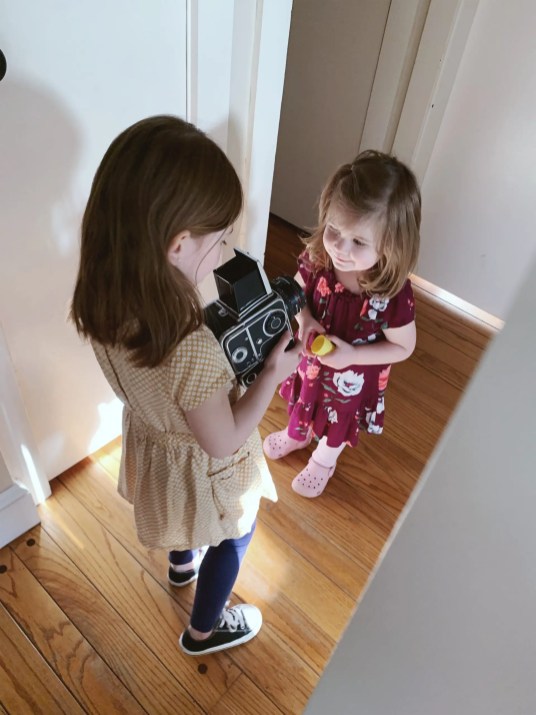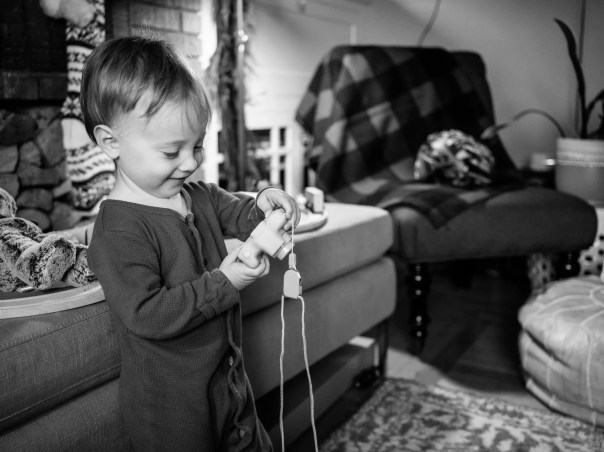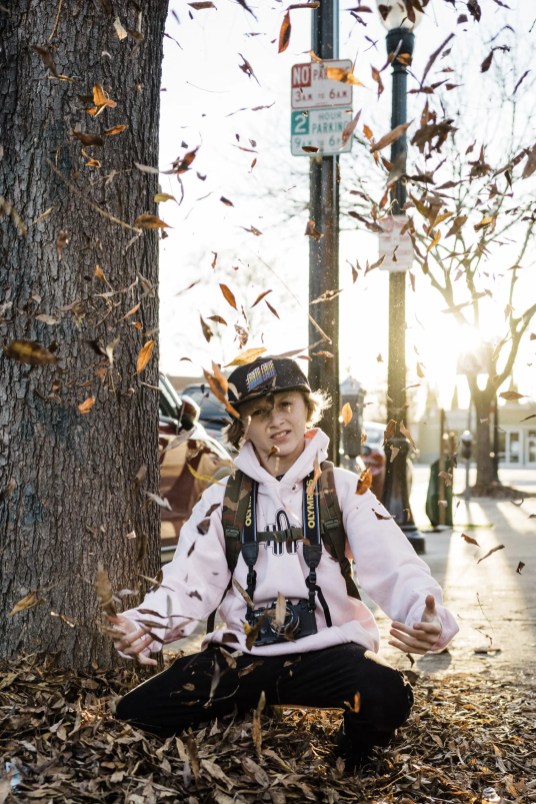I gave my daughter her first camera when she was just two years old. Since then, we’ve spent days taking photos together. And she’s made a lot of really great photos. Even the technically bad ones are great, in their way. They show a world that’s entirely hers; shots of our family, our vacations, pictures of the things that are important to her, a view of our day-to-day life that I’d never see if not for those photos. Giving her a camera was not only a nice gift and an opportunity for her to have some fun, the pictures she makes are a gift to me as well.
If you’re a photo geek and a parent, you should give your kid a camera. You should do this for many reasons, some that I’ve already hinted at, and others that are less emotionally charged but no less important. But if you’re not convinced, here are some reasons that cameras are good for kids.
Using a camera hones fine motor skills. Photo walks provide good exercise and fresh air (which facilitates longer naps – you’re welcome, parents). Peering through a viewfinder encourages the user to more closely and deeply observe the world around us. Photography can augment other hobbies or ignite other interests – my daughter’s camera has led her to further investigation of plants, nature, bugs, stars, architecture, airplanes, and more.
Film or digital? It doesn’t matter and each has its benefits. Shooting film can cultivate in children patience and attentiveness. It’s possible that the tangible nature of film will captivate them easier than digital files. It’s always nice to hold something, after all, and the magic of holding positive film in front of a light source never gets old. Digital cameras allow the child to see their work more quickly, which will help impatient youth stay engaged. Whatever image capture media you choose, the act of shooting, printing or developing and scanning, and seeing a final image invariably excites children and cultivates a culture of creating, which may prime young people for a longer-lasting lifestyle in which creating something is preferable to consuming something. This could be big.
Aside from all these acutely parental concerns, kids simply enjoy taking pictures. That counts for a lot.
So we all agree that cameras are good for young kids. But not all cameras are a good fit for young kids. Overcomplicated DSLRs will quickly confuse young kids when any one of the camera’s many settings dials is accidentally flicked off of Automatic. A big camera will be hard to hold. An overly technical camera will overwhelm and the child will lose interest. Expensive cameras will be quickly transformed into expensive shelf decorations in the buttery hands of a child who’s still discovering the terrible consequence of not respecting gravity.
The major criteria that make a camera a good camera for young kids are simple – size, weight, functionality, and price. The camera must be small enough and light enough that a kid will be able to hold it and use it comfortably. The camera must be simple to use, but also offer the child a chance to experiment and learn and grow (otherwise he or she will become bored quickly). And as kids get older, it’s important to provide them with a camera that can keep up with their needs and grow with them. Lastly, I’ve tended to select cameras that are extremely inexpensive, since I assume we’re not looking to spend hundreds of dollars on a camera for a little kid.
Following the criteria, the cameras that are most suitable for kids of different ages fall into a few neat categories. I’ll highlight the models that I’ve found to be the best fit for kids of different ages.
Best Cameras for Kids Aged 2 to 4
Canon Sure Shot Owl – For parents who want to introduce their little kids to the joys of shooting film, the best place to start will likely be a simple point-and-shoot. And there’s no simpler point-and-shoot (of decent quality) than the Canon Sure Shot Owl. It uses any standard 35mm film (ISO 400 is best), is light and compact, costs basically nothing, and is absurdly easy to use. Just point and then shoot.
What makes this particular point-and-shoot perfect for beginners, especially for younger kids (ages two, three, and four) is its truly massive viewfinder, which will help kids frame and compose their shots, and a big, soft shutter button on top which is easy for tiny kids to locate and press. Flash controls are activated by single button presses, unlike some other complicated point-and-shoots which use mode dials and difficult to decipher diagrams.
Made-for-Kids Digital Point-and-Shoot – For parents who want to introduce their little kids to the joys of digital photography, the best place to start could be any one of the numerous made-for-kids cameras that seem to be pouring out of China at the moment. These are often colorful, coated in rubber, and extremely simple to use. They also cost about $25, which is wild and unfathomable. Are they being made in a factory by political prisoners? Maybe. Are they destined to be unceremoniously dumped into a landfill? Probably. Are they of dubious quality? Yes. This is why I didn’t start my kids with a digital camera. But the option is here, if you want it.
Best Cameras for Kids Aged 4 to 8
Fujifilm Instax Mini 9 – We gave our four-year-old daughter a Fuji Instax Mini 9 for Christmas this year, and it’s become an immediate cherished object. She spent the holiday week snapping photo after photo, and she loves the fact that her shots are instantly available (Instax cameras are instant cameras). She presses the button and a photo pops out of the top of the camera. In about five minutes, it’s developed into a final image. This is fantastic for kids who want to see their work as soon as possible. The photos can then be stashed into albums or treasure boxes, or turned into instant keepsakes as the kid passes them out to willing recipients.
The Mini 9 is a great choice for little kids because it’s inexpensive, about $50, and comes in a variety of colors that kids will like. The viewfinder is easy to use, once they get the knack, and the simple controls help kids take effortless photos. There’s a power switch, a shutter button, and an exposure control which young kids won’t use, but older kids might. Most important, Fuji’s cameras just work perfectly every time. Exposure is spot on, photos look good.
As with all instant film cameras, the film can be expensive. The most popular Instax film product is the Mini two pack, which offers 20 Instax Mini photos for about $12. That’s not cheap, but it’s the most affordable instant film in the world right now. A good opportunity to teach children about the cost of goods and being conservative with their photography (“choose your shots carefully”). Instax film may also be a great incentive – “clean your room and you’ll get some film.”
Advanced 35mm Film Point-and-Shoot – As kids get a bit older, a veritable universe of high quality point-and-shoot film cameras begins to open up to them. With more advanced functionality, such as high quality zoom lenses, multiple picture modes, and more advanced flash modes, these cameras give children aged four to eight more options to play with. Best choices in this camera type come in the shape of Canon’s Sure Shot Zoom series, Pentax’s IQ Zoom series, and Olympus’ Stylus Zoom series. Any of these cameras should only cost between $30 and $60, depending on model. We sell these cameras in our shop for right around $45.
For my daughter, I chose a Canon Sure Shot Zoom 105u, one of the many advanced Sure Shot models made by Canon in the 1990s and 2000s. It’s got various exposure modes for night shooting, action shots, and a macro mode that my daughter loves. The Pentax IQ Zoom series are arguably sturdier and may be easier to use with larger controls and fewer mode buttons. I’ll likely give my younger daughter one of these when she asks for her own camera.
Advanced Digital Point-and-Shoot – Essentially offering all the same controls and growth potential as an advanced 35mm film point-and-shoot, these digital models will allow little kids to shoot more advanced photos as they grow up. Base models from Canon and Nikon are surprisingly affordable and amazingly capable – Canon’s Powershot Elph 180 is a serious digital camera for $108, while Nikon’s CoolPix A10 costs only $86. These two cameras would be arguably all the camera an adult would need, so for a kid just learning the joys of photography, they’re perfect.
Best Cameras for Kids Aged 8 to 12
Olympus OM2, Minolta X700 – For kids aged eight to twelve, it’s time to look at more serious cameras. For shooting film, the best choices are compact, lightweight, capable SLR cameras. And in this category there’s no better choice than the Olympus OM2 or Minolta’s X700. Both of these cameras are tiny and light, but also very high quality. They have large control dials, which will be helpful for smaller hands. They also have big, bright viewfinders that are easy to use, with very obvious metering systems that will help a child see how different settings and light sources impact their photography.
For kids new to photography especially, the OM2 and Minolta X700 are the ideal choice. This is because they have electronics to control auto-exposure. The OM2 offers aperture priority semi-auto exposure, meaning that the child will be able to control their lens aperture and learn the wonders of depth-of-field while letting the camera do the work of setting the shutter speed to create a correct exposure. Additionally the child can select manual mode, and control all aspects of their image. The X700 also offers aperture priority semi-auto exposure, but also includes full Program mode, which is automatic everything. When in this mode, the kid will simply need to point the camera, focus, and shoot. He or she can switch to semi-auto or full manual when they feel ready to explore those possibilities.
Either of these cameras will cost under $150, and that’s coming with a high quality lens. This is a phenomenal deal, considering that these cameras were once the everyday tools of professional photographers. They’re the type of camera that will last a lifetime and grow with a kid right through high school and college, into adulthood. That’s a legacy.
Fuji X100 – My choice for best digital camera for older kids is the original Fuji X100. This model can be found these days on eBay for under $300, and it’s an amazing camera by any measure. It’s gorgeous, well-made, and will take incredible pictures with as much or as little direct control as the user wants. I used one during a vacation earlier this year and it did everything I asked of it. It should do everything a twelve-year-old could want as well. If you want to spend real money on your kid, just buy the current X100 new, Moneybags.
Follow Casual Photophile on Facebook and Instagram
[Some of the links in this article will direct users to our affiliates at B&H Photo, Amazon, and eBay. By purchasing anything using these links, Casual Photophile may receive a small commission at no additional charge to you. This helps Casual Photophile produce the content we produce. Many thanks for your support.]















Great concept. Great article.